Flirting with Spring
In January and February, winter flirts with spring. Despite snow on the ground, there will be occasional warm days, balmy breezes and stunning blue skies that remind us of the rich colors of spring. On these flirtatious days, quince, forsythia and pussy willow begin to emerge from dormancy. With this slight swelling of buds, it is time to cut a few branches to bring spring indoors, so even when winter reappears with the next freeze or storm, we’re reminded of the warmer times to come.
Forcing Branches
Just like forcing bulbs, forcing branches will bring their buds into full beauty even if the outside weather isn’t quite right yet. To force branches, select plants that have set their buds in the fall or early winter. Look for branches with plump flower buds, and cut branches that you would have normally pruned in order to preserve the shape and health of the plant.
Next, scrape about 2 inches of the bark from the pruned end of the branch and make a 3-5 inch cut up the branch (lengthwise from the pruned end) to allow water to be absorbed. You can also split the end by carefully hammering it, but avoid crushing the tissues. Fill a tall container or vase with room-temperature water and floral preserver, then place the cut branches in it. Place the arrangement in a dimly lit room for 2-3 days, then move into a brighter area (but no direct sunlight). Change the water and cut 1 inch off the bottom of the stem each week. Mist the branches daily. Although they may take up to 3 weeks to bloom, the delightful bursts of color will be a celebrated reward for your time and efforts.
Flowering Branches for Forcing
Depending on when you want your buds to bloom, there are a variety of great branches you can work to force into brilliance even when spring is weeks away.
Early bloomers…
- Witch Hazel
- Cornelian Cherry
- Forsythia
- Pussy Willow
- Azalea
- Flowering Quince
For Later Blooms…
- Magnolia
- Apple
- Crab Apple
- Flowering Dogwood
- Hawthorn
- Red Bud
- Mockorange
Decorating With Forced Branches
There are many different ways you can add a little spring glory to your interior décor with forced branches. Consider…
- Using blooming branches in lieu of any flowers in vases.
- Putting shorter branches in bud vases on a windowsill.
- Adding branches to candle centerpieces or other arrangements.
- Twining thinner branches around a wreath form.
- Using the tallest branches in a tall, thin floor vase.
Spring will be here before you know it, and you can speed it along when you force branches to enjoy their blooms a few weeks early!
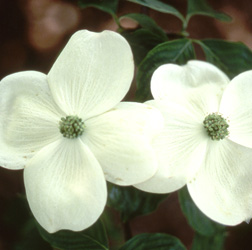
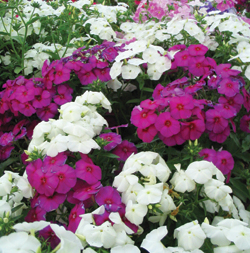
Dormant Pruning With the Proper Tools
Late winter pruning is often recommended for many trees and shrubs. Pruning the plants while they are dormant is less stressful for the plant and it’s also easier to view the structure of deciduous trees and shrubs without leaves to ensure the pruning helps create the desired shape. It’s also a time of the year when late winter sunshine makes us all long to be in our gardens and pruning is an excellent job to get us out there.
Pruning Tools
To get out and get pruning, you will need the proper tools. There are several types of pruners that should be in every serious gardener’s tool shed.
- Hand Pruners
The simplest tool, but the hardest to choose, is the hand pruner. There are two distinct styles of hand pruners: the anvil type and the bypass. The anvil pruner is good for pruning deadwood or undesirable growth. For more valuable specimens anvil pruners tend to smash the wood during cutting, leaving the wound open to insects and disease. Bypass pruners are like a pair of scissors and give you an easier, cleaner healthier cut. Different hand pruners are available in different sizes and grip styles, including options for both right-handed and left-handed gardeners. To get the best results, it is important to choose a hand pruner that feels comfortable but still provides adequate strength for the job.
- Lopping Shears
Another tool that comes in handy is the lopping shear. They are used for making larger cuts up to 1-1/2″ in diameter, and have longer handles to provide more power without stress or strain. The longer handles also provide a better reach than hand pruners. They are also excellent for clearing away undesirable growth in your yard, including trimming hedges.
- Pole Pruners
The last tool you’ll need is a pole pruner. It is a combination lopping shear and pruning saw. The pole pruner extends out to twelve feet and can be used for making small cosmetic cuts or larger limb removals without needing to set up a ladder. Pole pruners are also useful in dense canopies when using a ladder would not be practical or suitable.
To learn more about pruning specific trees or shrubs and to choose the appropriate tools for the job, please stop in or give us a call. We’ll be happy to help you be sure you are equipped to make clean, appropriate cuts that will help your trees and shrubs look their very best.
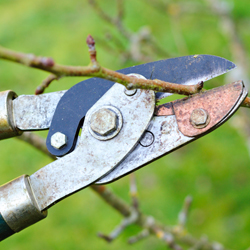
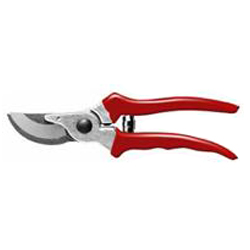
Design a Raised Landscape That Works
Raised beds have been around for years, but have become increasingly popular recently because they make the landscape orderly, organized and easy to maintain. You can readily reach over and pull weeds as they appear, plant more comfortably and enjoy the new tiered depth and dimension of your lawn and garden. Raised beds are also particularly helpful if you are working with heavy soils that drain poorly, or if you have mobility limits that make getting down to ground level more difficult.
If you’re just getting started with raised beds, it’s easy to successfully bring your gardening to a higher level:
- Define the bed lines with a rope or hose. Consider the overall bed size, as well as the size and shape of your building material. You may want to position the bed along a fence or in a corner for more dimension and support.
- Dig a 4-6” deep edge along the perimeter. Don’t worry if this line isn’t as neat as you would like, because it will be more refined once you construct the bed frame.
- Remove existing sod/grass from the bed. You can compost the removed material, or use it to patch other spots in your lawn or turf as needed.
- Place concrete blocks, wall stone or other edging along this new bed line to build your bed frame. Wooden railroad ties or planks can also be used, but be aware that they may warp or decay in time. In general, stone or other sturdy materials are preferred.
- Build up your flower bed approximately 6-8” with top soil, mixing in peat moss for better drainage and compost, leaf mulch, cow manure or similar organic material to adequately nourish the soil.
- Compact your soil mixture as you build up each layer. This will help keep the bed from settling excessively as you plant and water.
- Increase the visual impact of your flower bed or gardening area by planting at different levels. Arrange shorter, lower growing plants in front, followed by medium and then tall plants in the back. You might consider some “spiller” plants along the sides and front if desired. Choose plants carefully to match the size of the bed, avoiding plants that will quickly outgrow the smaller, more confined space.
- Apply a 2-3” layer of mulch or stone and thoroughly soak your new landscape feature. Sprinkle Miracle Gro Weed Preventer or a similar product over the area to provide an invisible layer of protection against germinating weeds.
Before you know it, your new raised bed will be thriving and will quickly become the centerpiece of your landscaping. Then it’s time to construct another!
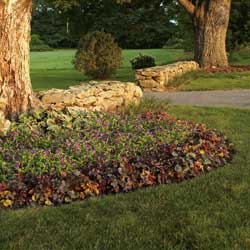
7 Top Trees for Multi-Season Interest
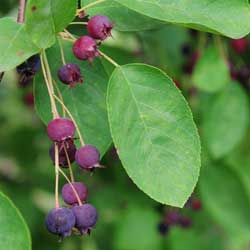 What’s not to love about a tree? As they grow, their photosynthesis removes and stores carbon dioxide, maintaining a safe oxygen level for us to breathe and cleaning pollutants out of the air. They provide beauty in our gardens and parks. Many provide shade, fruit, syrup, nesting places and animal refuges. They can be a windbreak or a privacy screen. They can be ornamental and practical all at once, and can thrive with little or no care.
What’s not to love about a tree? As they grow, their photosynthesis removes and stores carbon dioxide, maintaining a safe oxygen level for us to breathe and cleaning pollutants out of the air. They provide beauty in our gardens and parks. Many provide shade, fruit, syrup, nesting places and animal refuges. They can be a windbreak or a privacy screen. They can be ornamental and practical all at once, and can thrive with little or no care.
We want you to get the most enjoyment out of your trees. Therefore, we have selected seven underused but special trees for you to consider in your landscape. Very hardy, these trees provide all-year interest in mid-Atlantic gardens.
Of course, these aren’t the only trees with year-round interest. Harry Lauder’s Walkingstick, paperbark maple, tri-colored beech, ‘JN Strain’ musclewood and the various cherries are just a few others that can be showstoppers in your landscape throughout the year.
Come on in to see our diverse and incredible selection of beautiful trees. We’ll help you select the perfect one for your landscaping needs and ensure you enjoy it throughout the year.





